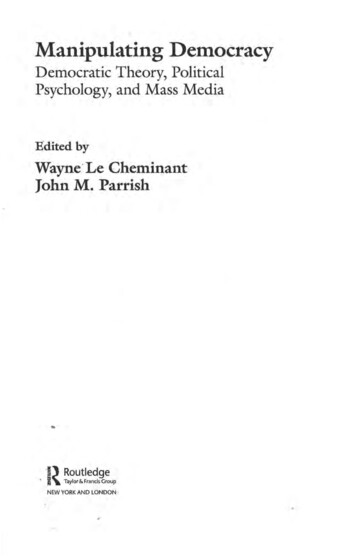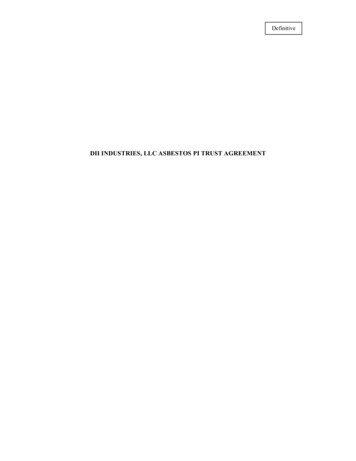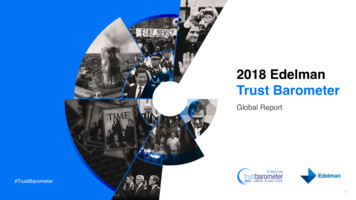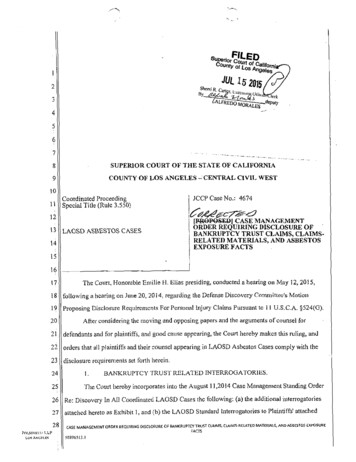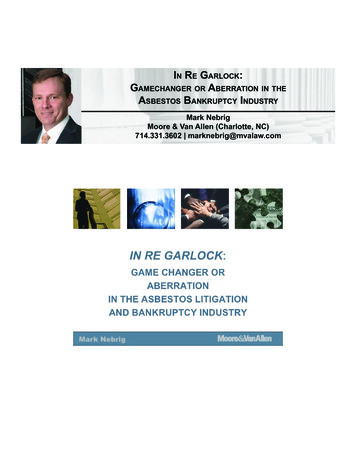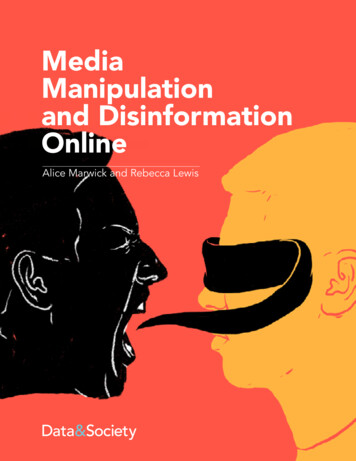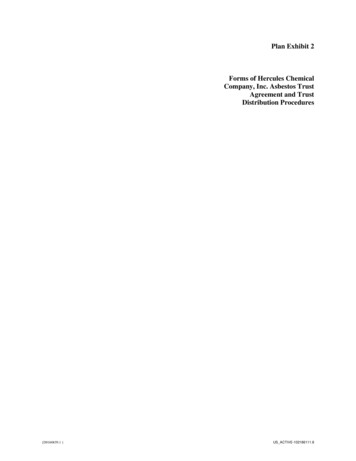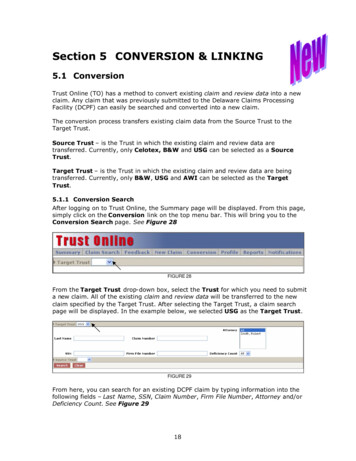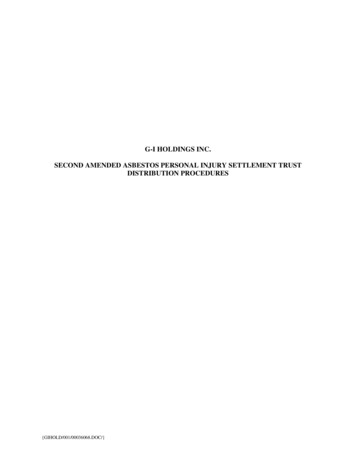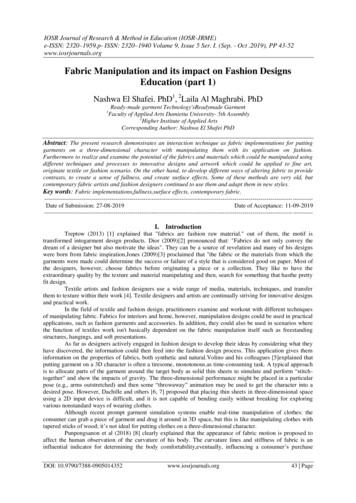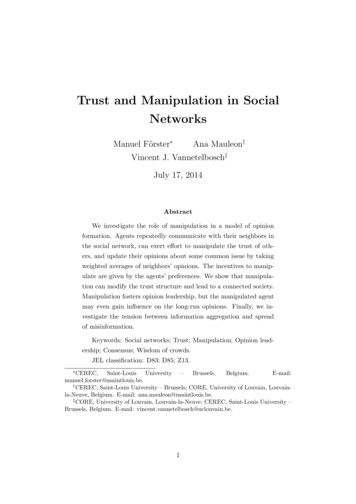
Transcription
Trust and Manipulation in SocialNetworksManuel Förster Ana Mauleon†Vincent J. Vannetelbosch‡July 17, 2014AbstractWe investigate the role of manipulation in a model of opinionformation. Agents repeatedly communicate with their neighbors inthe social network, can exert e ort to manipulate the trust of others, and update their opinions about some common issue by takingweighted averages of neighbors’ opinions. The incentives to manipulate are given by the agents’ preferences. We show that manipulation can modify the trust structure and lead to a connected society.Manipulation fosters opinion leadership, but the manipulated agentmay even gain influence on the long-run opinions. Finally, we investigate the tension between information aggregation and spreadof misinformation.Keywords: Social networks; Trust; Manipulation; Opinion leadership; Consensus; Wisdom of crowds.JEL classification: D83; D85; Z13. CEREC, Saint-Louis University – .be.†CEREC, Saint-Louis University – Brussels; CORE, University of Louvain, Louvainla-Neuve, Belgium. E-mail: ana.mauleon@usaintlouis.be.‡CORE, University of Louvain, Louvain-la-Neuve; CEREC, Saint-Louis University –Brussels, Belgium. E-mail: vincent.vannetelbosch@uclouvain.be.1
1IntroductionIndividuals often rely on social connections (friends, neighbors and coworkers as well as political actors and news sources) to form beliefs or opinionson various economic, political or social issues. Every day individuals makedecisions on the basis of these beliefs. For instance, when an individualgoes to the polls, her choice to vote for one of the candidates is influencedby her friends and peers, her distant and close family members, and someleaders that she listens to and respects. At the same time, the support ofothers is crucial to enforce interests in society. In politics, majorities areneeded to pass laws and in companies, decisions might be taken by a hierarchical superior. It is therefore advantageous for individuals to increasetheir influence on others and to manipulate the way others form their beliefs. This behavior is often referred to as lobbying and widely observed insociety, especially in politics.1 Hence, it is important to understand howbeliefs and behaviors evolve over time when individuals can manipulate thetrust of others. Can manipulation enable a segregated society to reach aconsensus about some issue of broad interest? How long does it take forbeliefs to reach consensus when agents can manipulate others? Can manipulation lead a society of agents who communicate and update naı̈velyto more efficient information aggregation?We consider a model of opinion formation where agents repeatedly communicate with their neighbors in the social network, can exert some e ort tomanipulate the trust of others, and update their opinions taking weightedaverages of neighbors’ opinions. At each period, first one agent is selectedrandomly and can exert e ort to manipulate the social trust of an agentof her choice. If she decides to provide some costly e ort to manipulateanother agent, then the manipulated agent weights relatively more the belief of the agent who manipulated her when updating her beliefs. Second,all agents communicate with their neighbors and update their beliefs usingthe DeGroot updating rule, see DeGroot (1974). This updating process issimple: using her (possibly manipulated) weights, an agent’s new belief isthe weighted average of her neighbors’ beliefs (and possibly her own belief)1See Gullberg (2008) for lobbying on climate policy in the European Union, andAusten-Smith and Wright (1994) for lobbying on US Supreme Court nominations.2
from the previous period. When agents have no incentives to manipulateeach other, the model coincides with the classical DeGroot model of opinionformation.The DeGroot updating rule assumes that agents are boundedly rational, failing to adjust correctly for repetitions and dependencies in information that they hear multiple times. Since social networks are often fairlycomplex, it seems reasonable to use an approach where agents fail to update beliefs correctly.2 Chandrasekhar et al. (2012) provide evidence from aframed field experiment that DeGroot “rule of thumb” models best describefeatures of empirical social learning. They run a unique lab experiment inthe field across 19 villages in rural Karnataka, India, to discriminate between the two leading classes of social learning models – Bayesian learningmodels versus DeGroot models.3 They find evidence that the DeGrootmodel better explains the data than the Bayesian learning model at thenetwork level.4 At the individual level, they find that the DeGroot modelperforms much better than Bayesian learning in explaining the actions ofan individual given a history of play.5Manipulation is modeled as a communicative or interactional practice,where the manipulating agent exercises some control over the manipulated agent against her will. In this sense, manipulation is illegitimate,see Van Dijk (2006). Notice that manipulating the trust of other agents(instead of the opinions directly) can be seen as an attempt to influencetheir opinions in the medium- or even long-run since they will continueto use these manipulated weights in the future.6 Agents only engage in2Choi et al. (2012) report an experimental investigation of learning in three-personnetworks and find that already in simple three-person networks people fail to accountfor repeated information. They argue that the Quantal Response Equilibrium (QRE)model can account for the behavior observed in the laboratory in a variety of networksand informational settings.3Notice that in order to compare the two concepts, they study DeGroot action models, i.e., agents take an action after aggregating the actions of their neighbors using theDeGroot updating rule.4At the network level (i.e., when the observational unit is the sequence of actions),the Bayesian learning model explains 62% of the actions taken by individuals while thedegree weighting DeGroot model explains 76% of the actions taken by individuals.5At the individual level (i.e., when the observational unit is the action of an individualgiven a history), both the degree weighting and the uniform DeGroot model largelyoutperform Bayesian learning models.6In our approach, the opinion of the manipulated agent is only a ected indirectlythrough the manipulated trust weights. Therefore, her opinion continues to be a ected3
manipulation if it is worth the e ort. They face a trade-o between theirincrease in satisfaction with the opinions (and possibly the trust itself) ofthe other agents and the cost of manipulation. In examples, we will frequently use a utility model where agents prefer each other agent’s opinionone step ahead to be as close as possible to their current opinion. Thisreflects the idea that the support of others is necessary to enforce interests. Agents will only engage in manipulation when it brings the opinion(possibly several steps ahead) of the manipulated agent sufficiently closerto their current opinion compared to the cost of doing so. In our view, thisconstitutes a natural way to model lobbying incentives.We first show that manipulation can modify the trust structure. If thesociety is split up into several disconnected clusters of agents and there arealso some agents outside these clusters, then the latter agents might connect di erent clusters by manipulating the agents therein. Such an agent,previously outside any of these clusters, would not only get influential onthe agents therein, but also serve as a bridge and connect them. As weshow by means of an example, this can lead to a connected society, andthus, make the society reaching a consensus.Second, we analyze the long-run beliefs and show that manipulationfosters opinion leadership in the sense that the manipulating agent alwaysincreases her influence on the long-run beliefs. For the other agents, thisis ambiguous and depends on the social network. Surprisingly, the manipulated agent may thus even gain influence on the long-run opinions. Asa consequence, the expected change of influence on the long-run beliefs isambiguous and depends on the agents’ preferences and the social network.We also show that a definitive trust structure evolves in the society and, ifthe satisfaction of agents only depends on the current and future opinionsand not directly on the trust, manipulation will come to an end and theyreach a consensus (under some weak regularity condition). At some point,opinions become too similar to be manipulated. Furthermore, we discussthe speed of convergence and note that manipulation can accelerate or slowdown convergence. In particular, in sufficiently homophilic societies, i.e.,societies where agents tend to trust those agents who are similar to them,by the manipulation in the following periods, but the extent might be diminished byfurther manipulations.4
and where costs of manipulation are rather high compared to its benefits,manipulation accelerates convergence if it decreases homophily and otherwise it slows down convergence.Finally, we investigate the tension between information aggregation andspread of misinformation. We find that if manipulation is rather costlyand the agents underselling their information gain and those oversellingtheir information lose overall influence (i.e., influence in terms of theirinitial information), then manipulation reduces misinformation and agentsconverge jointly to more accurate opinions about some underlying truestate. In particular, this means that an agent for whom manipulation ischeap can severely harm information aggregation.There is a large and growing literature on learning in social networks.Models of social learning either use a Bayesian perspective or exploit someplausible rule of thumb behavior.7 We consider a model of non-Bayesianlearning over a social network closely related to DeGroot (1974), DeMarzoet al. (2003), Golub and Jackson (2010) and Acemoglu et al. (2010). DeMarzo et al. (2003) consider a DeGroot rule of thumb model of opinionformation and they show that persuasion bias a ects the long-run processof social opinion formation because agents fail to account for the repetition of information propagating through the network. Golub and Jackson(2010) study learning in an environment where agents receive independentnoisy signals about the true state and then repeatedly communicate witheach other. They find that all opinions in a large society converge to thetruth if and only if the influence of the most influential agent vanishes asthe society grows.8Acemoglu et al. (2010) investigate the tension between information aggregation and spread of misinformation. They characterize how the presence of forceful agents a ects information aggregation. Forceful agentsinfluence the beliefs of the other agents they meet, but do not change theirown opinions. Under the assumption that even forceful agents obtain some7Acemoglu et al. (2011) develop a model of Bayesian learning over general socialnetworks, and Acemoglu and Ozdaglar (2011) provide an overview of recent research onopinion dynamics and learning in social networks.8Golub and Jackson (2012) examine how the speed of learning and best-responseprocesses depend on homophily. They find that convergence to a consensus is sloweddown by the presence of homophily but is not influenced by network density.5
information from others, they show that all beliefs converge to a stochasticconsensus. They quantify the extent of misinformation by providing boundson the gap between the consensus value and the benchmark without forceful agents where there is efficient information aggregation.9 Friedkin (1991)studies measures to identify opinion leaders in a model related to DeGroot.Recently, Büchel et al. (2012) develop a model of opinion formation whereagents may state an opinion that di ers from their true opinion becauseagents have preferences for conformity. They find that lower conformityfosters opinion leadership. In addition, the society becomes wiser if agentswho are well informed are less conform, while uninformed agents conformmore with their neighbors.Furthermore, Watts (2014) studies the influence of social networks oncorrect voting. Agents have beliefs about each candidate’s favorite policyand update their beliefs based on the favorite policies of their neighborsand on whom the latter support. She finds that political agreement in anagent’s neighborhood facilitates correct voting, i.e., voting for the candidatewho’s favorite policy is closest to his own favorite policy. Our paper isalso related to the literature on lobbying as costly signaling, e.g., AustenSmith and Wright (1994); Esteban and Ray (2006). These papers do notconsider networks and model lobbying as providing one-shot costly signalsto decision-makers in order to influence a policy decision.10To the best of our knowledge we are the first allowing agents to manipulate the trust of others in social networks and we find that the implicationsof manipulation are non-negligible for opinion leadership, reaching a consensus, and aggregating dispersed information.The paper is organized as follows. In Section 2 we introduce the modelof opinion formation. In Section 3 we show how manipulation can changethe trust structure of society. Section 4 looks at the long-run e ects ofmanipulation. In Section 5 we investigate how manipulation a ects theextent of misinformation in society. Section 6 concludes. The proofs are9In contrast to the averaging model, Acemoglu et al. (2010) have a model of pairwiseinteractions. Without forceful agents, if a pair meets two periods in a row, then in thesecond meeting there is no information to exchange and no change in beliefs takes place.10Notice that we study how (repeated) manipulation and lobbying a ect public opinion (and potientially single decision-makers) in the long-run, but do not model explicitlyany decision-making process.6
presented in Appendix A.2Model and NotationLet N {1, 2, . . . , n} be the set of agents who have to take a decision on some issue and repeatedly communicate with their neighbors inthe social network. Each agent i 2 N has an initial opinion or beliefxi (0) 2 R about the issue and an initial vector of social trust mi (0) (mi1 (0), mi2 (0), . . . , min (0)), with 0 mij (0) 1 for all j 2 N andPj2N mij (0) 1, that captures how much attention agent i pays (initially) to each of the other agents. More precisely, mij (0) is the initialweight or trust that agent i places on the current belief of agent j in forming her updated belief. For i j, mii (0) can be interpreted as how muchagent i is confident in her own initial opinion.At period t 2 N, the agents’ beliefs are represented by the vector x(t) (x1 (t), x2 (t), . . . , xn (t))0 2 Rn and their social trust by the matrix M (t) (mij (t))i,j2N .11 First, one agent is chosen (probability 1/n for each agent)to meet and to have the opportunity to manipulate an agent of her choice.If agent i 2 N is chosen at t, she can decide which agent j to meet andfurthermore how much e ort 0 she would like to exert on j. We writeE(t) (i; j, ) when agent i is chosen to manipulate at t and decides toexert e ort on j. The decision of agent i leads to the following updatedtrust weights of agent j:mjk (t 1) (mjk (t)/ (1 )if k 6 i.(mjk (t) ) / (1 ) if k iThe trust of j in i increases with the e ort i invests and all trust weights ofj are normalized. Notice that we assume for simplicity that the trust of jin an agent other than i decreases by the factor 1/(1 ), i.e., the absolutedecrease in trust is proportional to its level. If i decides not to invest anye ort, the trust matrix does not change. We denote the resulting updatedtrust matrix by M (t 1) [M (t)](i; j, ).Agent i decides on which agent to meet and on how much e ort to exert11We denote the transpose of a vector (matrix) x by x0 .7
according to her utility functionui M (t), x(t); j, vi [M (t)](i; j, ), x(t)ci (j, ),where vi [M (t)](i; j, ), x(t) represents her satisfaction with the otheragents’ opinions and trust resulting from her decision (j, ) and ci (j, )represents its cost. We assume that vi is continuous in all arguments andthat for all j 6 i, ci (j, ) is strictly increasing in 0, continuous andstrictly convex in 0, and that ci (j, 0) 0. Note that these conditionsensure that there is always an optimal level of e ort (j) given agent idecided to manipulate j.12 Agent i’s optimal choice is then (j , (j ))such that j 2 argmaxj6 i ui M (t), x(t); j, (j) .Secondly, all agents communicate with their neighbors and update theirbeliefs using the updated trust weights:x(t 1) [x(t)](i; j, ) M (t 1)x(t) [M (t)](i; j, )x(t).In the sequel, we will often simply write x(t 1) and omit the dependence on the agent selected to manipulate and her choice (j, ). We canrewrite this equation as x(t 1) M (t 1)x(0), where M (t 1) M (t 1)M (t) · · · M (1) (and M (t) In for t 1, where In is the n nidentity matrix) denotes the overall trust matrix.Now, let us give some examples of satisfaction functions that fulfill ourassumptions.Example 1 (Satisfaction functions).(i) Let2 N andvi [M (t)](i; j, ), x(t) 1n1X k6 ixi (t)M (t 1) x(t)k 2,where M (t 1) [M (t)](i; j, ). That is, agent i’s objective is thateach other agent’s opinion periods ahead is as close as possible12Note that for all j, vi (M (i; j, ), x) is continuous in and bounded from abovesince vi (·, x) is bounded from above on the compact set [0, 1]n n for all x 2 Rn . Intotal, the utility is continuous in 0 and since the costs are strictly increasing andstrictly convex in 0, there always exists an optimal level of e ort, which might notbe unique, though.8
to her current opinion, disregarding possible manipulations in futureperiods.(ii)vi [M (t)](i; j, ), x(t) xi (t)1n1Xk6 ixk (t 1)!2,where xk (t 1) [M (t)](i; j, )x(t) k . That is, agent i wants to beclose to the average opinion in society one period ahead, but disregards di erences on the individual level.We will frequently choose in examples the first satisfaction functionwith parameter 1, together with a cost function that combines fixedcosts and quadratic costs of e ort.Remark 1. If we choose satisfaction functions vi v for some constant vand all i 2 N , then agents do not have any incentive to exert e ort andour model reverts to the classical model of DeGroot (1974).We now introduce the notion of consensus. Whether or not a consensusis reached in the limit depends generally on the initial opinions.Definition 1 (Consensus). We say that a group of agents G N reachesa consensus given initial opinions (xi (0))i2N , if there exists x(1) 2 R suchthatlim xi (t) x(1) for all i 2 G.t!13The Trust StructureWe investigate how manipulation can modify the structure of interaction ortrust in society. We first shortly recall some graph-theoretic terminology.13We call a group of agents C N minimal closed at period t if these agentsPonly trust agents inside the group, i.e., j2C mij (t) 1 for all i 2 C, and ifthis property does not hold for a proper subset C 0 ( C. The set of minimalclosed groups at period t is denoted C(t) and is called the trust structure.13See Golub and Jackson (2010).9
A walk at period t of length K is a sequence of agents i1 , i2 , . . . , iK 1 suchthat mik ,ik 1 (t) 0 for all k 1, 2, . . . , K. A walk is a path if all agentsare distinct. A cycle is a walk that starts and ends in the same agent. Acycle is simple if only the starting agent appears twice in the cycle. We saythat a minimal closed group of agents C 2 C(t) is aperiodic if the greatestcommon divisor14 of the lengths of simple cycles involving agents from Cis 1.15 Note that this is fulfilled if mii (t) 0 for some i 2 C.At each period t, we can decompose the set of agents N into minimalclosed groups and agents outside these groups, the rest of the world, R(t):N [C2C(t)C [ R(t).Within minimal closed groups, all agents interact indirectly with each other,i.e., there is a path between any two agents. We say that the agents arestrongly connected. For this reason, minimal closed groups are also calledstrongly connected and closed groups, see Golub and Jackson (2010). Moreover, agent i 2 N is part of the rest of the world R(t) if and only if there isa path at period t from her to some agent in a minimal closed group C 63 i.We say that a manipulation at period t does not change the trust structure if C(t 1) C(t). It also implies that R(t 1) R(t). We find thatmanipulation changes the trust structure when the manipulated agent belongs to a minimal closed group and additionally the manipulating agentdoes not belong to this group, but may well belong to another minimalclosed group. In the latter case, the group of the manipulated agent isdisbanded since it is not anymore closed and its agents join the rest of theworld. However, if the manipulating agent does not belong to a minimalclosed group, the e ect on the group of the manipulated agent depends onthe trust structure. Apart from being disbanded, it can also be the casethat the manipulating agent and possibly others from the rest of the worldjoin the group of the manipulated agent.Proposition 1. Suppose that E(t) (i; j, ), 0, at period t.For a set of integers S N, gcd(S) max {k 2 N m/k 2 N for all m 2 S} denotesthe greatest common divisor.15Note that if one agent in a simple cycle is from a minimal closed group, then so areall.1410
(i) Let i 2 N , j 2 R(t) or i, j 2 C 2 C(t). Then, the trust structure doesnot change.(ii) Let i 2 C 2 C(t) and j 2 C 0 2 C(t)\{C}. Then, C 0 is disbanded, i.e.,C(t 1) C(t)\{C 0 }.(iii) Let i 2 R(t) and j 2 C 2 C(t).(a) Suppose that there exists no path from i to k for any k 2 [C 0 2C(t)\{C} C 0 .Then, R0 [ {i} joins C, i.e.,C(t 1) C(t)\{C} [ {C [ R0 [ {i}},where R0 {l 2 R(t)\{i} there is a path from i to l}.(b) Suppose that there exists C 0 2 C(t)\{C} such that there exists apath from i to some k 2 C 0 . Then, C is disbanded.All proofs can be found in Appendix A. The following example showsthat manipulation can enable a society to reach a consensus due to changesin the trust structure.Example 2 (Consensus due to manipulation). Take N {1, 2, 3} andassume thatui M (t), x(t); j, 1Xxi (t)2 k6 ixk (t 1)2 2 1/10 · 1{ 0} ( )for all i 2 N . Notice that the first part of the utility is the satisfactionfunction in Example 1 part (i) with parameter 1, while the second part,the costs of e ort, combines fixed costs, here 1/10, and quadratic costs ofe ort. Let x(0) (10, 5, 5)0 be the vector of initial opinions and01.8 .2 0BCM (0) @.4 .6 0A0 0 1be the initial trust matrix. Hence, C(0) {{1, 2}, {3}}. Suppose that firstagent 1 and then agent 3 are drawn to meet another agent. Then, at period11
0, agent 1’s optimal decision is to exert 2.5416 e ort on agent 3. Thetrust of the latter is updated tom3 (1) (.72, 0, .28) ,while the others’ trust does not change, i.e., mi (1) mi (0) for i 1, 2,and the updated opinions becomex(1) M (1)x(0) (9, 7, 5.76)0 .Notice that the group of agent 3 is disbanded (see part (ii) of Proposition1). In the next period, agent 3’s optimal decision is to exert .75 e orton agent 1. This results in the following updated trust matrix:01.46 .11 .43BCM (2) @ .4 .6 0 A .72 0 .28Notice that agent 3 joins group {1, 2} (see part (iii,a) of Proposition 1) andtherefore, N is minimal closed, which implies that the group will reach aconsensus, as we will see later on.However, notice that if instead of agent 3 another agent is drawn inperiod 1, then agent 3 never manipulates since when finally she wouldhave the opportunity, her opinion is already close to the others’ opinionsand therefore, she stays disconnected from them. Nevertheless, the agentswould still reach a consensus in this case due to the manipulation at period0. Since agent 3 trusts agent 1, she follows the consensus that is reachedby the first two agents.4The Long-Run DynamicsWe now look at the long-run e ects of manipulation. First, we study theconsequences of a single manipulation on the long-run opinions of minimalclosed groups. In this context, we are interested in the role of manipulation in opinion leadership. Secondly, we investigate the outcome of the16Stated values are rounded to two decimals for clarity reasons.12
influence process. Finally, we discuss how manipulation a ects the speedof convergence of minimal closed groups and illustrate our results by meansof an example.4.1Opinion LeadershipTypically, an agent is called opinion leader if she has substantial influenceon the long-run beliefs of a group. That is, if she is among the most influential agents in the group. Intuitively, manipulating others should increaseher influence on the long-run beliefs and thus foster opinion leadership.To investigate this issue, we need a measure for how remotely agentsare located from each other in the network, i.e., how directly agents trustother agents. For this purpose, we can make use of results from Markov(t)chain theory. Let (Xs )1s 0 denote the homogeneous Markov chain inducedby the transition matrix M (t). The agents are then interpreted as statesof the Markov chain and the trust of i in j, mij (t), is interpreted as thetransition probability from state i to state j. Then, the mean first passage(t)(t)time from state i to state j is defined as E[inf{s 0 Xs j} X0 i].Given the current state of the Markov chain is i, the mean first passagetime to j is the expected time it takes for the chain to reach state j.In other words, the mean first passage time from i to j corresponds tothe average (expected) length of a random walk on the weighted networkM (t) from i to j that takes each link with probability equal to the assignedweight.17 This average length is small if the weights along short paths fromi to j are high, i.e., if agent i trusts agent j rather directly. We thereforecall this measure weighted remoteness of j from i.Definition 2 (Weighted remoteness). Take i, j 2 N , i 6 j. The weightedremoteness at period t of agent j from agent i is given byrij (t) E[inf{s(t)0 Xs(t) j} X0 i],(t)where (Xs )1s 0 is the homogeneous Markov chain induced by M (t).17More precisely, it is a random walk on the state space N that, if currently in statek, travels to state l with probability mkl (t). The length of this random walk to j is thetime it takes for it to reach state j.13
The following remark shows that the weighted remoteness attains itsminimum when i trusts solely j.Remark 2. Take i, j 2 N , i 6 j.(i) rij (t)1,(ii) rij (t) 1 if and only if there is a path from i to j, and, in particular, if i, j 2 C 2 C(t),(iii) rij (t) 1 if and only if mij (t) 1.To provide some more intuition, let us look at an alternative (implicit)formula for the weighted remoteness. Suppose that i, j 2 C 2 C(t) aretwo distinct agents in a minimal closed group. By part (ii) of Remark 2,the weighted remoteness is finite for all pairs of agents in that group. Theunique walk from i to j with (average) length 1 is assigned weight (or hasprobability, when interpreted as a random walk) mij (t). And the averagelength of walks to j that first pass through k 2 C\{j} is rkj (t) 1, i.e.,walks from i to j with average length rkj (t) 1 are assigned weight (haveprobability) mik (t). Thus,rij (t) mij (t) Xmik (t)(rkj (t) 1) .k2C\{j}Finally, applyingPk2Cmik (t) 1 leads to the following remark.Remark 3. Take i, j 2 C 2 C(t), i 6 j. Then,rij (t) 1 Xmik (t)rkj (t).k2C\{j}Note that computing the weighted remoteness using this formula amountsto solving a linear system of C ( C 1) equations, which has a uniquesolution.We denote by (C; t) the probability vector of the agents’ influence onthe final consensus of their group C 2 C(t) at period t, given that the groupis aperiodic and the trust matrix does not change any more.18 In this case,18In the language of Markov chains, (C; t) is known as the unique stationary distribution of the aperiodic communication class C. Without aperiodicity, the class mightfail to converge to consensus.14
the group converges tox(1) (C; t)0 x(t) C X i (C; t)xi (t),i2Cwhere x(t) C (xi (t))i2C is the restriction of x(t) to agents in C. Inother words, i (C; t), i 2 C, is the influence weight of agent i’s opinionat period t, xi (t), on the consensus of C. Notice that the influence vector (C; t) depends on the trust matrix M (t) and therefore it changes withmanipulation. A higher value of i (C; t) corresponds to more influence ofagent i on the consensus. Each agent in a minimal closed group has atleast some influence on the consensus: i (C; t) 0 for all i 2 C.19We now turn back to the long-run consequences of manipulation andthus, opinion leaders. We restrict our analysis to the case where both themanipulating and the manipulated agent are in the same minimal closedgroup. Since in this case the trust structure is preserved we can comparethe influence on the long-run consensus of the group before and after manipulation.Proposition 2. Suppose that at period t, group C 2 C(t) is aperiodic andE(t) (i; j, ), i, j 2 C. Then, aperiodicity is preserved and the influenceof agent k 2 C on the final consensus of her group changes as follows, k (C; t 1) k (C; t) (P /(1 ) i (C; t) j (C; t 1) l2C\{i} mjl (t)rli (t)P /(1 ) k (C; t) j (C; t 1)l2C\{k} mjl (t)rlk (t) if k i .rik (t) if k 6 iCorollary 1. Suppose that at period t, group C 2 C(t) is aperiodic andE(t) (i; j, ), i, j 2 C. If 0, then(i) agent i strictly increases her long-run influence, i (C; t 1) i (C; t),(ii) any other agent k 6 i of the group can either gain or lose influence,depending on the trust matrix. She gains if and only ifXmjl (t) rlk (t
Trust and Manipulation in Social Networks Manuel F orster Ana Mauleon† Vincent J. Vannetelbosch‡ July 17, 2014 Abstract We investigate the role of manipulation in a model of opinion formation. Agents repeatedly communicate with their neighbors in the social
